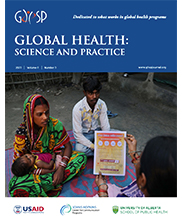The global effort to protect all people from vaccine-preventable diseases has historically leveraged multidose containers in low- and middle-income countries to offer lower prices and reduce the constraints on cold chain space. However, as newer, more expensive vaccines are introduced in multidose formats, the burden of cost-efficiency potentially moves from the national-level to the health care worker.
To achieve maximum utilization of every dose in a vial and depending on the country’s policies, health care workers need to be strategic about when to open a vial and be diligent about how they care for open vials. In addition, they have to be more active with community outreach and communication to ensure optimal attendance and timely immunization. For these reasons, the number of doses per container (DPC) can hinder a country’s ability to achieve timely and equitable coverage including reaching the urban poor or rural remote. DPC can also influence additional factors like vaccine safety, system costs, supply chain, and wastage.
The qualitative studies described here (see Methods section) were part of a larger multicountry project to improve the evidence base on HCWs’ decision making relative to DPC. This article focuses on qualitative findings on HCWs’ perspectives on BCG and MCV, obtained through formative research in Senegal and Vietnam and a prospective study in Zambia. The project also conducted household surveys to examine immunization coverage, administered facility surveys to conduct cost-effectiveness analyses and studied routine administrative data from facilities to assess vaccine wastage. The findings from those studies are forthcoming in other journals.
In this article, we report on the BCG and MCV vaccines since they are common to all 3 countries, are supplied in MDVs, and must be discarded after 6 hours. Zambia and Senegal use a 10-dose measles-rubella (MR) vial and a 20-dose BCG vial. Vietnam uses 10-dose MCV (both measles and MR) and BCG vials; measles first dose is given at 9 months and MR vaccine (second dose) is given at 18 months.
The qualitative studies described here (see Methods section) were part of a larger multicountry project to improve the evidence base on HCWs’ decision making relative to DPC. This article focuses on qualitative findings on HCWs’ perspectives on BCG and MCV, obtained through formative research in Senegal and Vietnam and a prospective study in Zambia. The project also conducted household surveys to examine immunization coverage, administered facility surveys to conduct cost-effectiveness analyses, and studied routine administrative data from facilities to assess vaccine wastage. The findings from those studies are forthcoming in other journals.
In this article, we report on the BCG and MCV vaccines since they are common to all 3 countries, are supplied in MDVs, and must be discarded after 6 hours. Zambia and Senegal use a 10-dose measles-rubella (MR) vial and a 20-dose BCG vial. Vietnam uses 10-dose MCV (both measles and MR) and BCG vials; measles first dose is given at 9 months and MR vaccine (second dose) is given at 18 months.
Authors: Natasha Kanagat, Kristin Krudwig, Karen A. Wilkins, Sydney Kwame, Guissimon Phiri, Frances D. Mwansa, Mercy Mvundura, Joanie Robertson, Debra Kristensen, Abdoulaye Gueye, Sang D. Dao, Pham Q. Thai, Huyen T. Nguyen and Thang C. Tran


